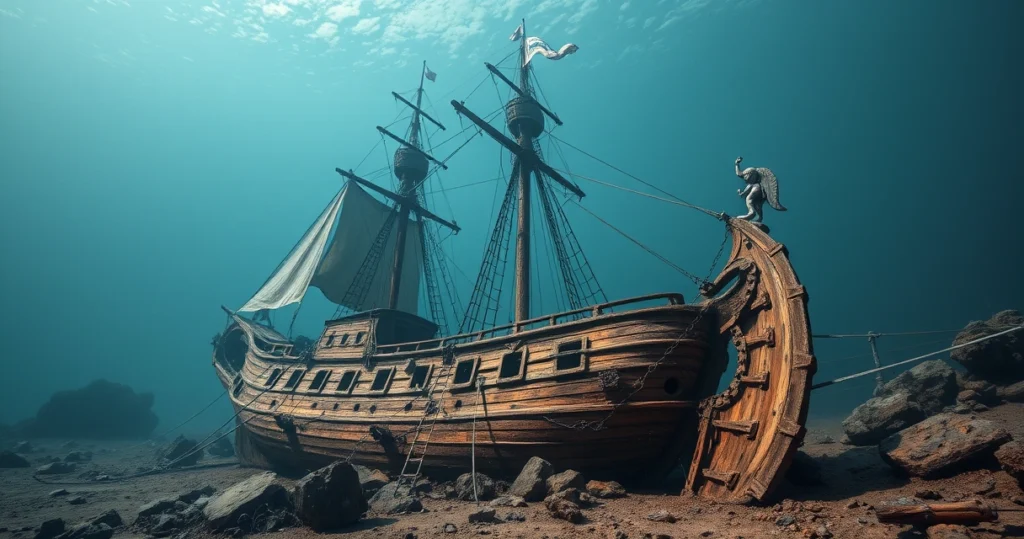In an extraordinary revelation that has captivated historians, archaeologists, and treasure hunters alike, researchers have identified a shipwreck off the coast of Madagascar as a 300-year-old Portuguese vessel. This ship, laden with treasures, was reportedly captured by pirates in the year 1721. The discovery not only sheds light on maritime history and piracy but also offers a rare glimpse into the trade routes and practices of the early 18th century.

This remarkable find is part of ongoing archaeological efforts to explore and understand the intricacies of historical maritime activities in the Indian Ocean. With Madagascar’s strategic location, it played a significant role in trade and piracy during the Age of Sail. The wreck is a testament to the tumultuous history of this region, where adventure, risk, and treasure intertwined.
Understanding the Historical Context
The Indian Ocean has long been a crossroads of trade, culture, and conflict. During the early 18th century, European nations were deeply involved in maritime exploration and colonization, leading to both economic gains and fierce competition. The Portuguese, who were among the pioneering explorers of the Indian Ocean, established extensive trade networks.
The Rise of Piracy
Piracy flourished in these waters due to the lucrative nature of trade. Ships laden with gold, spices, and other valuable cargo became prime targets for pirates. The wreck discovered off Madagascar is emblematic of this era, where the clash between merchant vessels and pirates was a common occurrence.
The Discovery of the Pirate Shipwreck
The shipwreck was discovered by a team of researchers conducting underwater archaeological surveys in the vicinity of Madagascar. Utilizing advanced sonar technology alongside traditional diving techniques, they were able to locate the remnants of the ship buried beneath layers of sand and sediment. The identification as a Portuguese vessel came from distinctive artifacts and structural elements that align with known specifications of ships from that period.
Significance of the Findings
The discovery of this shipwreck is profound for several reasons:
- Historical Insight: It offers a window into the maritime practices of the 18th century, including shipbuilding techniques, cargo loading, and navigation.
- Cultural Exchange: The artifacts recovered from the site can illustrate the interaction between European, African, and Asian cultures during the Age of Sail.
- Preservation of Heritage: Understanding these shipwrecks aids in the preservation of maritime history and encourages sustainable archaeological practices.
Artifacts and Treasures Unearthed
While the shipwreck itself is a historical treasure, the artifacts recovered from the site have raised excitement among archaeologists. Initial findings include:
- Coins: Gold and silver coins minted in Portugal that were likely part of the ship’s cargo.
- Weapons: Remnants of cannons and firearms used for defense against pirate attacks.
- Everyday Items: Personal belongings of the crew, which provide a glimpse into their daily lives at sea.
Analyzing the Artifacts
Each artifact recovered can tell a unique story. Coins, for instance, can be traced to specific mints and years, offering clues about the ship’s journey and trade routes. The presence of weapons indicates the risks faced by merchant vessels during that time, while personal items can reveal the cultural backgrounds of the crew members.
The Role of Technology in Underwater Archaeology
The successful identification of this shipwreck highlights the vital role that technology plays in modern archaeology. Advanced sonar imaging allows researchers to map underwater landscapes with precision, while remotely operated vehicles (ROVs) can explore depths that divers cannot reach. These tools not only enhance the discovery process but also ensure that archaeological sites are documented and preserved effectively.
Future Prospects for the Wreck Site
As research continues, there are plans to conduct further excavations and studies of the site. This could lead to the recovery of more artifacts and a deeper understanding of the ship’s history. Additionally, researchers aim to collaborate with local communities to promote awareness and education surrounding the heritage of Madagascar’s maritime history.
Frequently Asked Questions (FAQs)
1. What is the significance of the shipwreck discovered in Madagascar?
The shipwreck is significant as it provides insights into 18th-century maritime practices, piracy, and cultural exchanges among different civilizations during the Age of Sail.
2. How was the shipwreck identified as a Portuguese vessel?
The identification was made through the analysis of artifacts, structural elements of the ship, and historical records that match the characteristics of known Portuguese ships from that period.
3. What kinds of artifacts have been found at the site?
Artifacts include coins, weapons, and everyday items belonging to the crew, which offer a glimpse into the maritime culture of the time.
4. What technologies are used in underwater archaeological research?
Researchers utilize sonar imaging, remotely operated vehicles (ROVs), and advanced diving equipment to explore and document underwater sites effectively.
5. What are the future plans for the shipwreck site?
Future plans include further excavations, studies of the artifacts, and collaboration with local communities to promote education and awareness about the region’s maritime heritage.
Conclusion
The discovery of the ancient pirate shipwreck off the coast of Madagascar serves as a fascinating chapter in the narrative of maritime history. With its roots in the tumultuous world of 18th-century piracy, this shipwreck not only represents a significant archaeological find but also a treasure trove of knowledge about historical trade routes and cultural interactions. As researchers continue to study and recover artifacts from this site, they will undoubtedly uncover more stories from the past, enriching our understanding of the maritime world and its enduring legacy.
📰 Original Source
Este artigo foi baseado em informações de: https://olhardigital.com.br/2025/07/03/ciencia-e-espaco/naufragio-de-navio-atacado-por-piratas-ha-300-anos-e-descoberto-em-madagascar/



